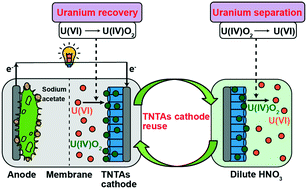Recovery and separation of uranium in a microbial fuel cell using a titanium dioxide nanotube array cathode†
Abstract
Uranium is a common radionuclide contaminant in groundwater. Recovery of uranium from uranium-containing water can achieve the dual purposes of uranium remediation and uranium resource utilization. However, very few studies have successfully achieved this task. In this study, we developed a microbial fuel cell (MFC) system with a titanium dioxide nanotube array (TNTA) cathode, which could efficiently remove (over 95%) and recover (over 97%) uranium from uranium-containing water. Results demonstrated that the removal of U(VI) in the MFC was through an adsorption–reduction–deposition mechanism. U(VI) was adsorbed by the TNTA cathode, and the adsorbed U(VI) was further electroreduced to U(IV)O2 and deposited on the surface of the TNTA cathode. The reduction of adsorbed U(VI) initiated re-equilibration of the desorption reaction of adsorbed U(VI) and induced re-adsorption of U(VI). The re-adsorbed U(VI) could be further electroreduced to U(IV)O2, which resulted in the continuous removal of U(VI). Finally, 2.95 μmol U(VI) was reduced and deposited as U(IV)O2 on the surface of the TNTAs (1476.22 μmol m−2) without observing capacity saturation. Moreover, the deposited U(IV)O2 can be easily separated from the TNTA cathode with dilute nitric acid, and the TNTA cathode can be used repeatedly with stable performance.

- This article is part of the themed collection: Environmental Remediation


 Please wait while we load your content...
Please wait while we load your content...